Introduction
Poly A, polyadenylate, is a mixture of 100-10000 polyadenylates, which is polymerized by polynucleotide phosphorylasein vitro. In vivo, poly (a) is added to the 3-terminal of mRNA by enzyme to improve the stability of mRNA. In the application of nucleic acid extraction, adding poly A to the lysate or binding solution can improve the yield of DNA and RNA. The mechanism of poly A improving the yield of nucleic acid is as follows:
1. Saturated contact with the surface adsorption of articles. Most polypropylene articles have static electricity on the surface, which will adsorb nucleic acids. Carrier RNA can saturate these adsorption effects and reduce the loss of target nucleic acids.
2. Inactivate trace nucleases: There are various nucleases in biological samples and environment. Poly A can inactivate trace nucleases in the extraction or preservation steps to improve the yield and stability of target nucleic acids.
3. Coprecipitation: In the nucleic acid purification step of alcohol mediated precipitation or binding, poly A can coprecipitate with the target nucleic acid or form polymerparticles to improve the recovery.



